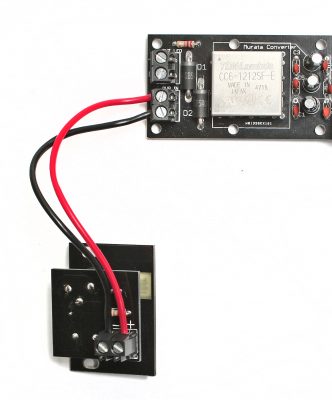Important Links
Product Page
Store Page
Assembly Instructions
Bill of Materials
Manual
Capacitor and Resistor Lookup Guide
Thank you for purchasing the Synthrotek Eurorack Case Power kit! This is an intermediate build. It is very important to get all the components properly soldered into the PCB in the correct placement. If you feel like you can handle it, please proceed! If not, get some help from a friend with experience or purchase a fully completed unit.
Attention: The Molex connector, 16-Pin Flying Bus Connectors and Spade Connectors on the Case Power are only for connecting to a distribution board(s). DO NOT connect a Case Power to another Case Power, Case Power MINI, Deluxe Power or Super Power via the molex connector or 16-Pin Flying Bus Connectors, or Spade Connectors. This WILL damage the power converters and void your warranty.
ATTN: Please follow the BOM and these instructions. Don’t populate from the PCB silkscreen or these instruction pictures alone. Our components may look different from the pictures, so please look over your parts and check the codes first.
LET’S BEGIN
We will begin by assembling the main power supply PCB. This kit can be purchased with an optional 3U or 1U Eurorack panel, or it can be purchased with an LED and DC Jack. We will show those assembly instructions at the end of the page.
RESISTORS
Resistors are not polarized so it doesn’t matter which way they are placed in, but it makes troubleshooting a lot easier if you line up all of the tolerance bands (usually a gold stripe) on the same side. Insert each resistor, matching the value to the proper spot as per the BOM.
NOTE: the value of R4 is dependent on the color of LED and desired brightness. If you purchased a NON-PANEL Kit from us it includes a BLUE LED and a 22K resistor. If you are using your own RED LED then you can use a 2.2K resistor for R4. If you are using the Eurorack panel, you do not need to populate R4, but you can if you like.
Once they are all in there, carefully flip your project over and solder the resistors in place. Clip any excess leads.
LEDs
Now place the three 3mm LEDs into the PCB by aligning the longer of the two leads into the hole that is by “+” side on the board. Carefully flip your project over and solder the LEDs in place. Clip any excess leads.
CERAMIC CAPACITORS
Up next are the ceramic capacitors. These aren’t polarized, and can be inserted into the PCB in any direction. Once you get them all in there, go ahead and flip the project over, solder the legs, and clip any excess leads. An easy way to get these guys nice and flat is to only solder one leg of the capacitor first, then re-align it while reheating the solder pad.
DIODES
Diodes are polarized, so be careful to align the cathode stripe on the diode with the same cathode strip on the silkscreen. When these are in place, you can flip the project over onto a hard flat surface, and solder them in place. Clip the excess part of the leads.
-12V CONVERTER AND +5V CONVERTER
The Case Power Mini has two -12V regulator options:
- TDK for up to 500 mA of possible current draw
- MuRata for up to 1.3A of possible current draw
Each converter will fit in the PCB in only one way. For these instructions we will be populating the MuRata converter, rest assured the rest of the instructions will work perfectly with the TDK chip as well.
When you populate the +5v Regulator, it may have a tendency to rotate a little bit before it is completely soldered in. Make sure to align it so that it is not bumping into anything else on the board.
16-PIN EURORACK POWER HEADERS
Populate the ten Eurorack 16-Pin keyed power connectors as shown above by aligning the keyed notch on the power connectors with the notch on the silk screen on the PCB as shown above. THIS IS VERY IMPORTANT!!! Now use a piece of cardboard or other flat surface to press against the headers and turn over and solder in place.
HEADERS AND +12V REGULATOR
Now populate the two 2-pin screw clamp power headers so that the holes on the screw clamp headers face the end of the board.
Populate the molex connector with the holes facing the edge of the board, as shown above.
There are two options for the +12v regulator in the Case Power Mini.
-1A Traco (TSR-1-24120)
-2A Traco (TSR-2-24120)
Each one has a small dot on the front of it, indicating which of the three pins are pin 1. There is also a corresponding dot on the PCBs silkscreen. Make sure while populating this regulator that you match these two indicators up.
Once you have everything in place, carefully flip your project over and solder everything in place.
ELECTROLYTIC CAPACITORS
Up next are the electrolytic capacitors. The electrolytic capacitors are polarized, so make sure when populating it that the longer lead goes into the hole with a “+” next to it. Once you have everything in place, go ahead and flip the project over and solder everything into place. Clip the excess leads.
1U and 3U EURORACK PANELS (Optional)
If you purchased a 1U or 3U Eurorack panel kit, proceed with these assembly instructions. If you purchased a NO-PANEL kit, scroll down the page to those instructions.
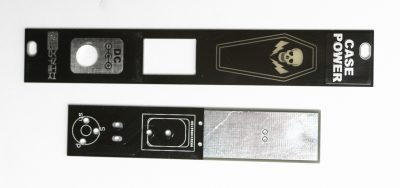
3U CASE POWER EURORACK PANEL and PCB
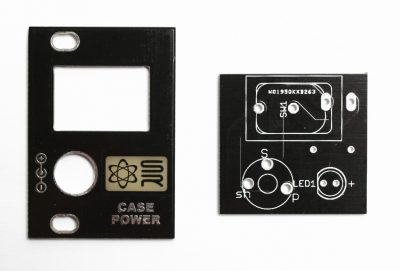
1U CASE POWER EURORACK PANEL and PCB
RESISTOR
Populate the resistor, turn the board over and solder it in place. Clip excess leads.

3U CASE POWER RESISTOR
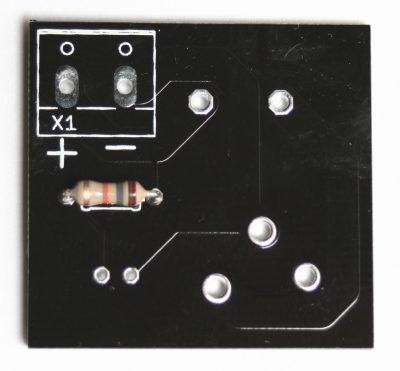
1U CASE POWER RESISTOR
LED
The LED is polarized and must be installed in the proper orientation. Make sure that the longer lead pokes through the PCB in the hole that has the “+” marking next to it. The 3U PCB has a reflective surface that will look best if you bend over the LED as shown below. Turn over, solder and clip.
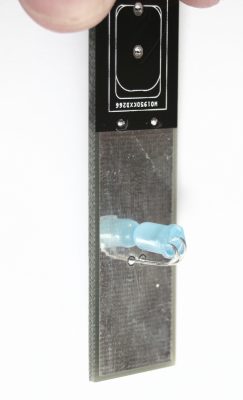
3U CASE POWER LED
Do not bend over the LED on the 1U PCB, just slide it in as shown below. Turn over, solder and clip.
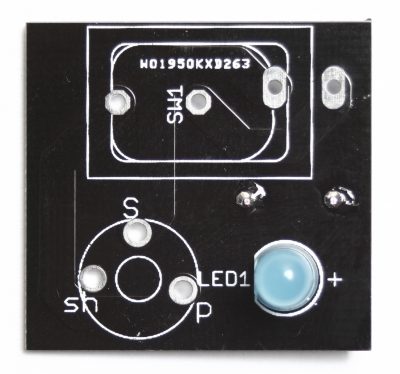
1U CASE POWER LED
SCREW CLAMP HEADER
Now populate the 2-Pin screw clamp header in the orientation as shown below. Turn over and solder in place.
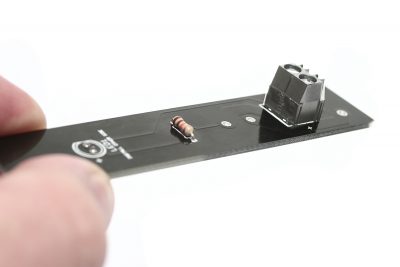
3U Panel Screw Clamp Header
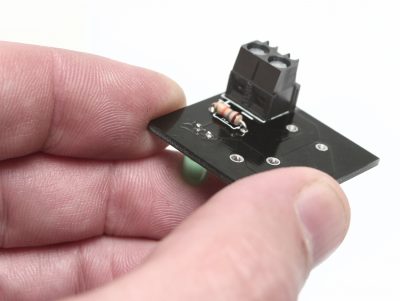
1U Panel Screw Clamp Header
POWER SWITCH
Now snap in the power switch EXACTLY as shown below. It must be inserted this way to connect the PCB properly.

3U SWITCH
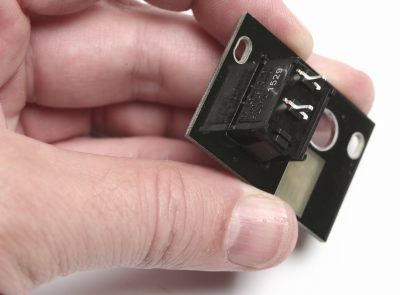
1U SWITCH
DC JACK
Populate the DC Jack (it will only fit one way) BUT DO NOT SOLDER JUST YET!
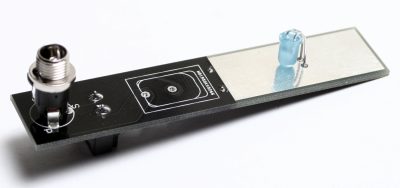
3U DC JACK
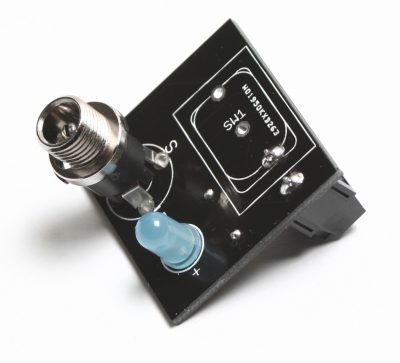
1U DC JACK
PANEL ALIGNMENT
Now place the panel onto the PCB by inserting the leads from the switch and the DC jack into the PCB. You can also tighten the DC jack nut down at this time (not overly tight). Take your time to make sure that the panel and PCB are parallel to each other. Once you feel confident, turn over and solder them into place. You are now done with the PCB assembly! Congrats! Now it is time to connect your panel to the main CASE POWER with the 16AWG wire included in your kit.

3U PANEL ALIGNMENT
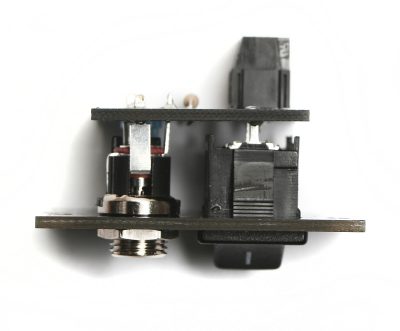
1U Power Entry
We recommend that you tin the tips of the wire before inserting into the screw clamp headers. Connect the 16AWG Red wire to both screw clamp headers (main board and front panel PCB) with the “+” next to it. Do the same for black (to the “-“) and tighten down. See photos below for reference.
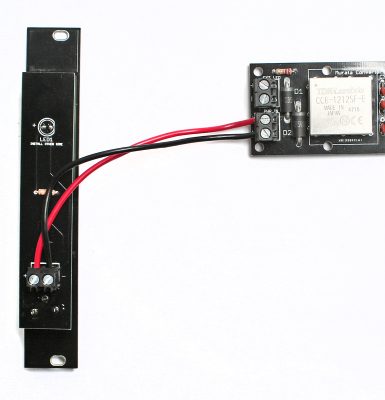
3U Power Panel Wiring
NO-PANEL JACK AND LED WIRING
If you purchased a kit with no Eurorack front panel please follow these instructions. Included in your kit is a DC jack, a toggle switch, some 16AWG wire, an LED, an LED Bezel with a plastic insert and some heat shrink tubing. These components are good for mounting into a case that is not very deep or if you plan on boring out wood holes etc to make these fit. If you are going to use the LED bezel, you will need to put the plastic insert on BEFORE you solder wires to the LED. Here are some photographs showing how you can wire these parts up.
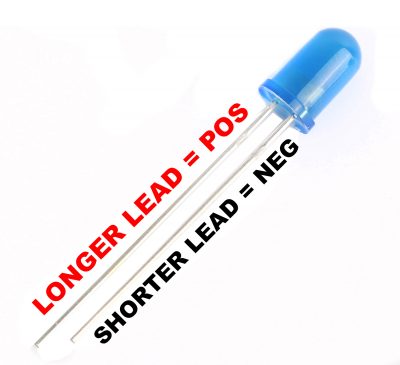
LED ORIENTATION
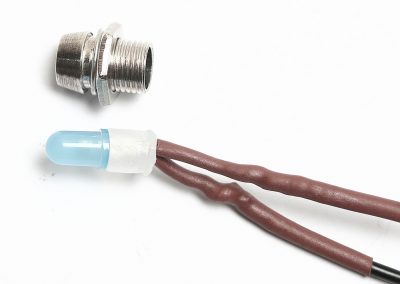
CASE POWER LED WITH BEZEL
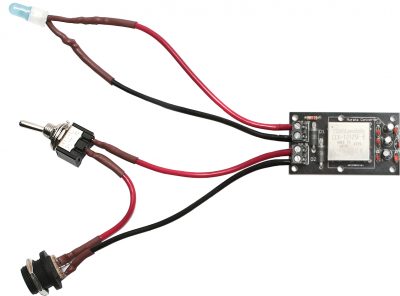
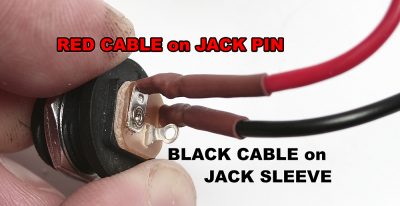
CASE POWER DC JACK
EXTRAS:
If you plan on powering 2 or more Case Powers or Case Power Minis with a single brick (make sure that your brick and cable gauge can handle the amp draw!), you can daisy-chain CASE POWERS using the Power IN and Power OUT screw clamp headers as shown below:
Attention: The Molex connector, 16-Pin Flying Bus Connectors and Spade Connectors on the Case Power are only for connecting to a distribution board(s). DO NOT connect a Case Power MINI to another Case Power, Case Power MINI, Deluxe Power or Super Power via the molex connector or 16-Pin Flying Bus Connectors, or Spade Connectors. This WILL damage the power converters and void your warranty. ONLY USE THE METHOD SHOWN BELOW.
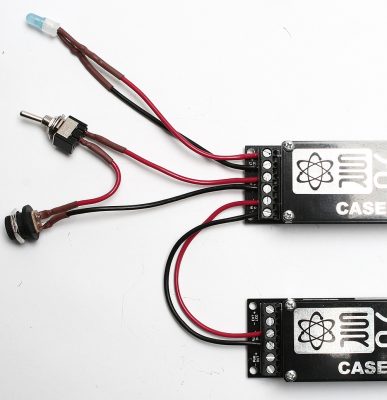
DAISY CHAIN 2 or more CASE POWERS to ONE POWER BRICK
Testing the Case Power Mini
To test the Case Power Mini, you will need the following tools:
Volt meter or digital multimeter.
To test your Case Power Mini’s functionality, plug your 12v power brick into the DC jack that you wired up earlier. Before you turn it on, make sure that you are a couple feet away. (Or wear safety glasses). Also be sure not to have any modules plugged in during the test. Then flip the power switch.
If you hear a loud pop, or see smoke, or smell anything burning IMMEDIATELY remove the power from the jack!!
If the three LEDs turned on, then you have a working Case Power Mini, but we are going to check the voltages on the rails to make sure there isn’t a solder bridge between two of the power suppplies.
With your volt meter set to DC Voltage, put the black probe on a ground connection (like the screw clamp header) and then touch the red one to each of the pins on the 16 pin power header. Be careful not to bridge two pins with your probe lead. See the photo below for what pins should have what voltages.












